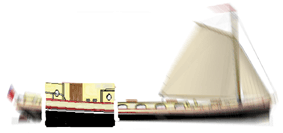 |
|
 |
|
 |
Bathroom <> Bow-Locker <> Build-Story <> Cloakroom <> Deck-Area <> Drive-Steering <> Electrics-Room <> Hallway <> Kitchen/Galley <> Lounge/Saloon <> Master-Bedroom <> Rear-Storage <> Spud-Leg <> Study/Bedroom <> Tech-Specs <> Wheelhouse |
If you ever want a real challenge, go through the spec sheets of marine diesel engine manufacturers and make a choice, it is the proverbial lottery. We should add that, in this day and age, it is very difficult to find a high volume manufacturer building poor quality engines. This is due to the vast diversity the basic engine is used: diesel cars & light commercials, motorised small earth-moving equipment, static hospital generators, etc.
| Not so with the other powered devices this barge of ours needs, in particular, the bow & stern thrusters. There are many and varied makes and types but the one which stood out for us is made by ARS. Part of our plan for the drive is hydraulics by Hydrosta, primarily because they allow us to package the engines away from the centreline of the barge which frees-up this lowest part of the craft (keel area) to facilitate more headroom for our fore and aft hallway directly under the wheelhouse. |
PORT SIDE |
We certainly wanted hydraulic rather than electric thrusters because we are not seasoned bargees, consequently we would need all the navigation aids we could place at our disposal. ARS hydraulic bow & stern thrusters can run 24/7 so, in the event of a navigational 'cock-up' we would be able to turn JENAL around on the proverbial sixpence (or dime). These thrusters will make mooring in tight spaces easier too, particularly in adverse windy conditions. | ||
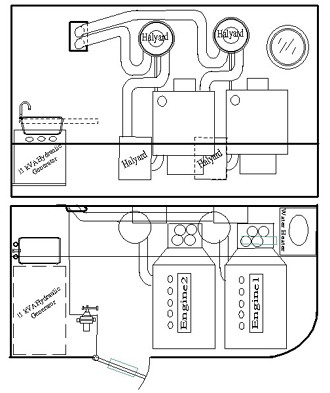 |
||||
|
STARBOARD SIDE |
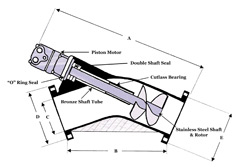 |
One other key difference between the ARS thrusters and the rest is their method of propulsion, they use a stainless steel Archimedes screw rather than a propeller. The benefits are many and these include; improved thrust, compact packaging and the most important to us, it resembles our kitchen mincing machine? As strange as it sounds, this Archimedes screw deign will mince most trapped debris rather than clog, as props often do. And there can be a lot of debris floating around inland waterways, marinas and harbours! Click here for more info. | |
| Our
opening remarks about
engine observations led us to
Volvo-Penta's
door-step and we chose a pair of their D3-110 diesel
engines. These are variable geometry turbo's with 5 cylinders, all
aluminium and based on the engines used in the Volvo car range - therefore internationally
serviceable! It has 295Nm of torque @ 1500rpm and peaks over
340Nm @ just 2000rpm. BHP is, as the model name implies, 110 @ 2600rpm. Being a 5 cylinder, it will be smooth and being from a car it will be compact and relatively light. It also meets all the 2006 EU emissions legislations. |
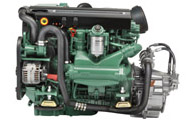 |
| Duel (or twin) engines in a barge are an unusual set-up and we chose this approach not for speed- it is a barge after all - we just wanted to reduce the oft problem of; under-utilised marine diesels sooting and smoking whilst casually cruising the inland waterways. Our plan is to alternate the use of each of the Volvo-Penta's in non-tidal waters and use them both where water current and sea conditions dictate. The two engines also offer us a greater margin of safety if we have a failure at sea. Click here for more info. | ||||
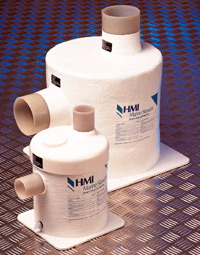
|
One of my personal marine dislikes is the ploop, ploop noise emanating from water cooled exhausts. Halyard have come to the rescue with their excellent silencer and water separator system. It quietens the exhaust and separates the water from the system via a gravity drain. The end result is no water plooping from the hull exhaust outlets which makes for a quiet, pure sound and no future rust trails down the hull. Talking of rust, the Halyard systems are made from a composite material which cannot rust - bliss! |
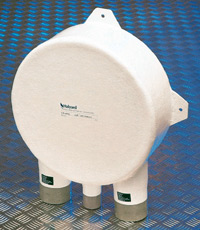 |
||
|
The Hydrosta hydraulic drive from the D3-110's will not only drive the Duodrive's but also power the ARS bow & sternthrusters, the windlass for the mast hoist, the 13.5Kva generator, wheelhouse, bow locker doors, spud-legs plus any other needy devise... most useful! Click here for more info. |
||||
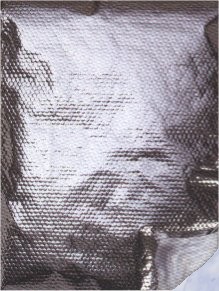 |
We are using 3M's Thinsulate for the engine rooms temperature insulation and sound absorber, this means that we can use Thinsulate in the cavity walls as well. It is a metalised material (silver-faced rather than normal black), this silver-faced Thinsulate needs their special adhesive tape between the joints to comply with RCD regs. for non-absorbency of fuels etc. Due to Thinsulates' lightweight it is ideally suited to the roof sections of our Klipper as well. This will reduce heat ingress, into the wheelhouse above. To find out more, go to UK Thinsulate distributor DMS |
| HOME <> SITE MAP <> CONTACT US <> ABOUT US <> PUBLIC PRESENTATIONS <> JENAL DIARY<> JENAL BUILD PICS <> SUPPLIER CONTACTS <> DUTCH BARGE ASSOCIATION |